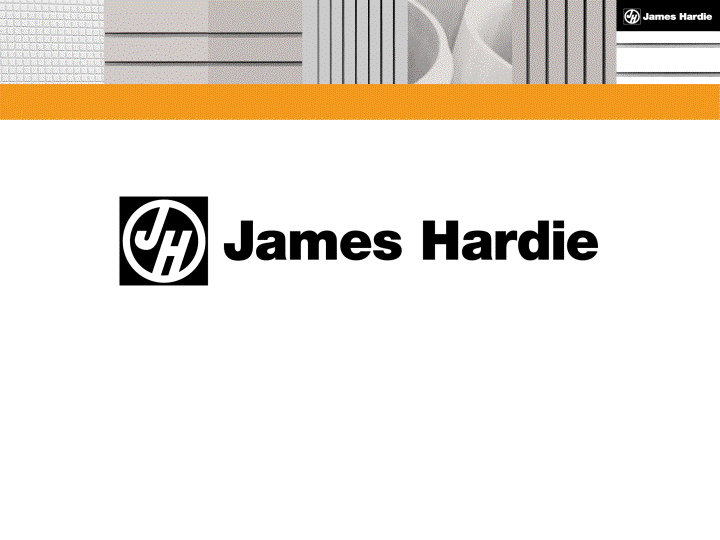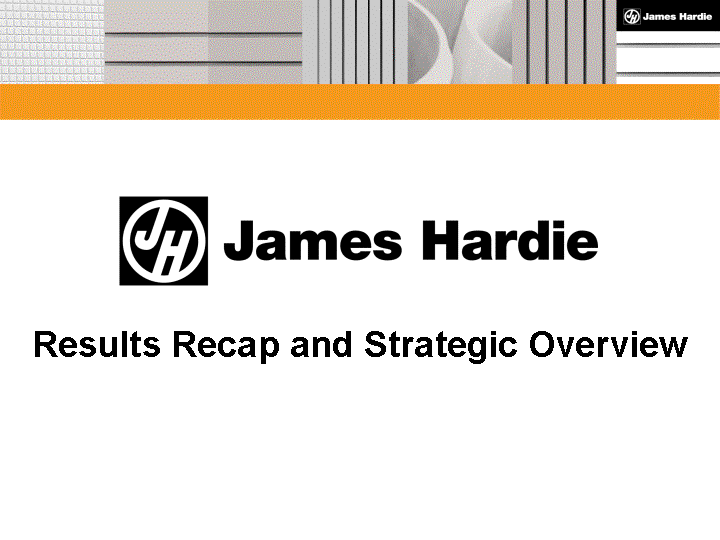
EXHIBIT 99.1

| Results Recap and Strategic Overview |

| US$ Million Q1 '04 Q1 '03 % Change Net Sales 241.5 194.6 24 Gross Profit 89.3 68.5 30 SG&A (36.2) (30.1) 20 Research & Development (4.8) (3.3) 45 EBIT 48.3 35.1 38 Net Interest Expense (2.3) (2.9) (21) Other Income, Net - 0.3 - Income Tax Expense (13.1) (10.1) 30 Operating Profit6 32.9 22.4 47 Continuing businesses only Results - Q1 |
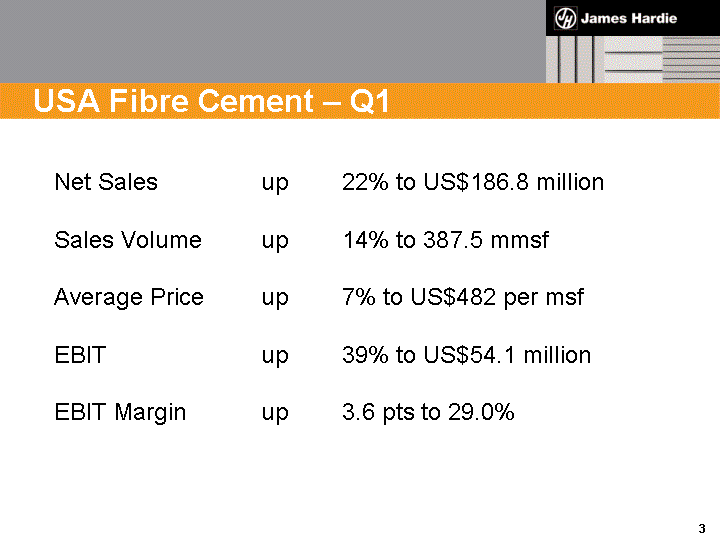
| Net Sales up 22% to US$186.8 million Sales Volume up 14% to 387.5 mmsf Average Price up 7% to US$482 per msf EBIT up 39% to US$54.1 million EBIT Margin up 3.6 pts to 29.0% USA Fibre Cement - Q1 |
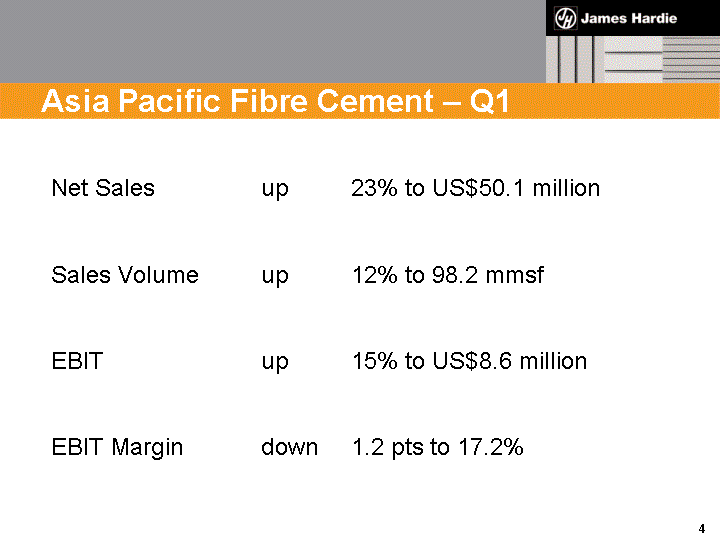
| Net Sales up 23% to US$50.1 million Sales Volume up 12% to 98.2 mmsf EBIT up 15% to US$8.6 million EBIT Margin down 1.2 pts to 17.2% Asia Pacific Fibre Cement - Q1 |

| Other Fibre Cement - Q1 Chile - breakeven, growing share Pipes - volumes trebled, prices low Europe - positive start Roofing - trials commenced |

| EBITDA - Q1 Continuing businesses only See Note 4 Q1'04 Q1'03 % Change EBIT3 USA Fibre Cement Asia Pacific Fibre Cement Other Fibre Cement R & D Corporate 54.1 8.6 (3.7) (3.3) (7.4) 38.8 7.5 (2.7) (2.5) (6.0) 39 15 (37) (32) (23) Depreciation and Amortization USA Fibre Cement Asia Pacific Fibre Cement Other Fibre Cement 4.9 2.3 0.1 4.8 2.1 0.0 2 10 - Total (EBITDA) 55.6 42.0 32 |
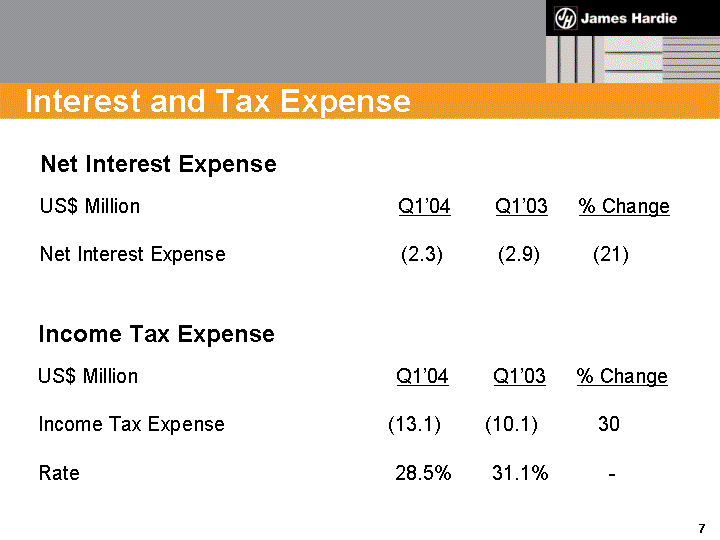
| Interest and Tax Expense Net Interest Expense Net Interest Expense Net Interest Expense Net Interest Expense US$ Million Q1'04 Q1'03 % Change Net Interest Expense (2.3) (2.9) (21) Income Tax Expense Income Tax Expense Income Tax Expense Income Tax Expense US$ Million Q1'04 Q1'03 % Change Income Tax Expense (13.1) (10.1) 30 Rate 28.5% 31.1% - |
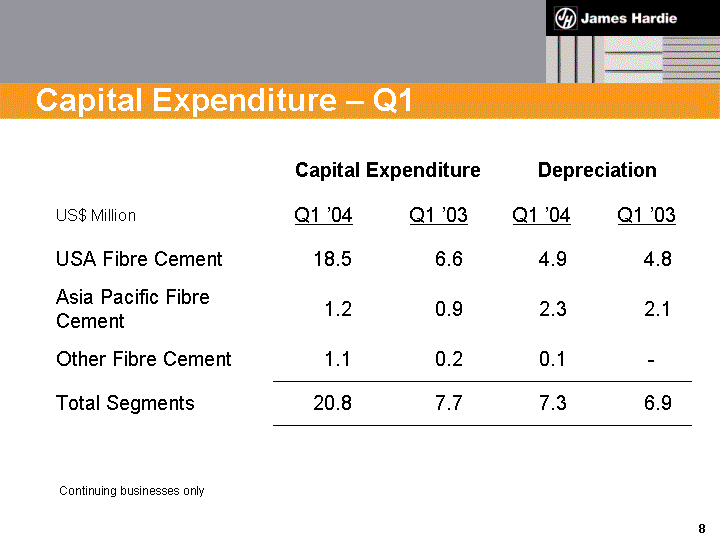
| Capital Expenditure - Q1 Capital Expenditure Capital Expenditure Depreciation Depreciation US$ Million Q1 '04 Q1 '03 Q1 '04 Q1 '03 USA Fibre Cement 18.5 6.6 4.9 4.8 Asia Pacific Fibre Cement 1.2 0.9 2.3 2.1 Other Fibre Cement 1.1 0.2 0.1 - Total Segments 20.8 7.7 7.3 6.9 Continuing businesses only |
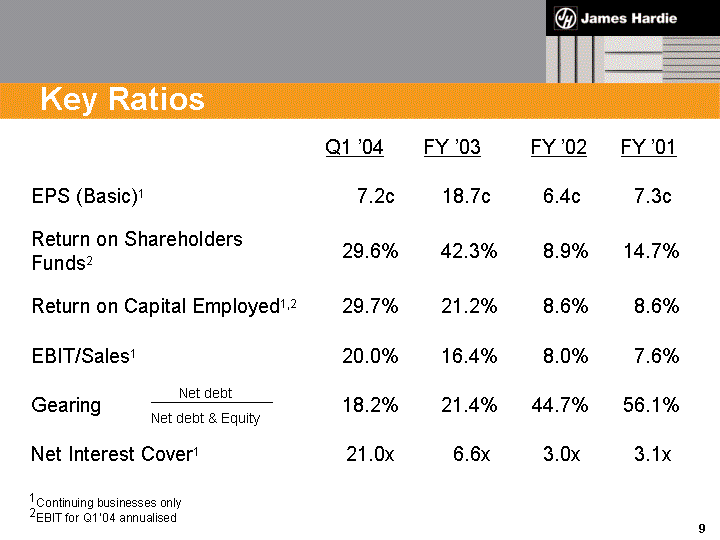
| Key Ratios Q1 '04 FY '03 FY '02 FY '01 EPS (Basic)1 7.2c 18.7c 6.4c 7.3c Return on Shareholders Funds2 29.6% 42.3% 8.9% 14.7% Return on Capital Employed1,2 29.7% 21.2% 8.6% 8.6% EBIT/Sales1 20.0% 16.4% 8.0% 7.6% Gearing 18.2% 21.4% 44.7% 56.1% Net Interest Cover1 21.0x 6.6x 3.0x 3.1x 1Continuing businesses only 2EBIT for Q1'04 annualised |
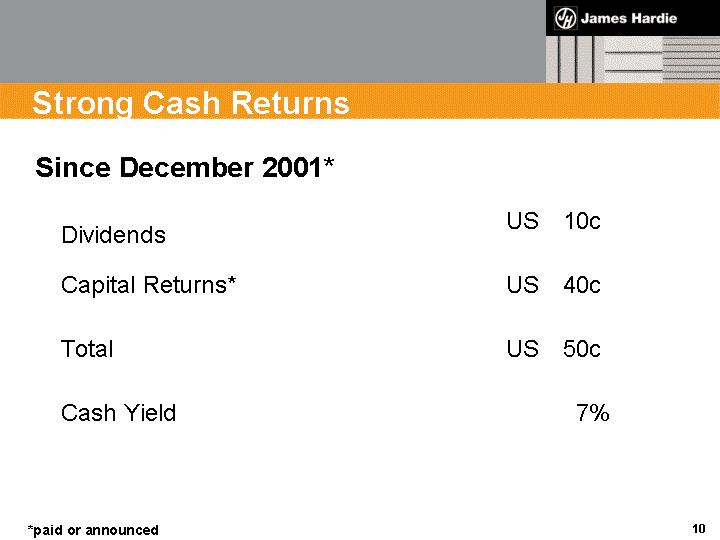
| Strong Cash Returns Since December 2001* Dividends US US 10c Capital Returns* US US 40c Total Total US 50c Cash Yield 7% *paid or announced |
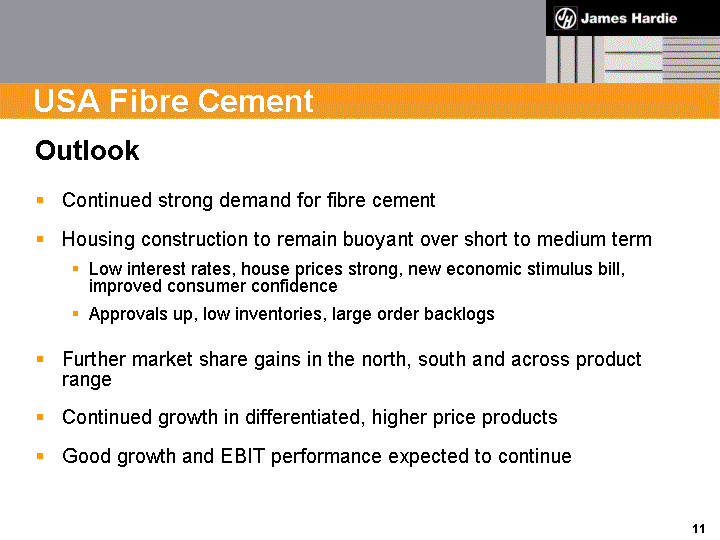
| USA Fibre Cement Outlook Continued strong demand for fibre cement Housing construction to remain buoyant over short to medium term Low interest rates, house prices strong, new economic stimulus bill, improved consumer confidence Approvals up, low inventories, large order backlogs Further market share gains in the north, south and across product range Continued growth in differentiated, higher price products Good growth and EBIT performance expected to continue |
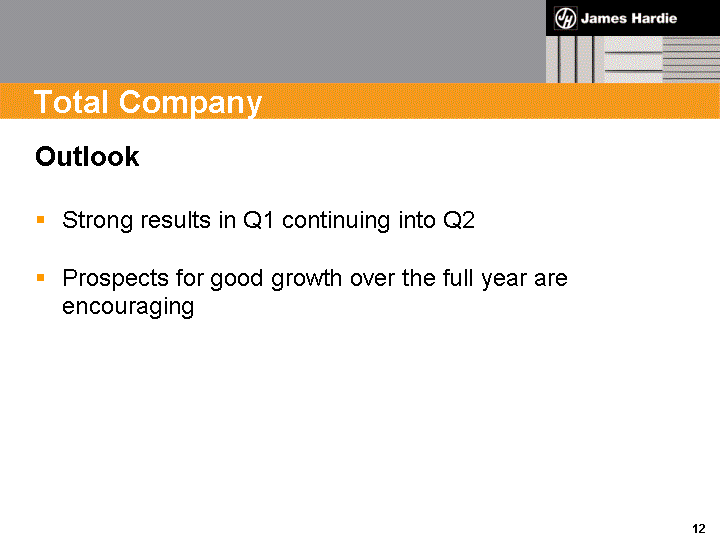
| Total Company Outlook Strong results in Q1 continuing into Q2 Prospects for good growth over the full year are encouraging |
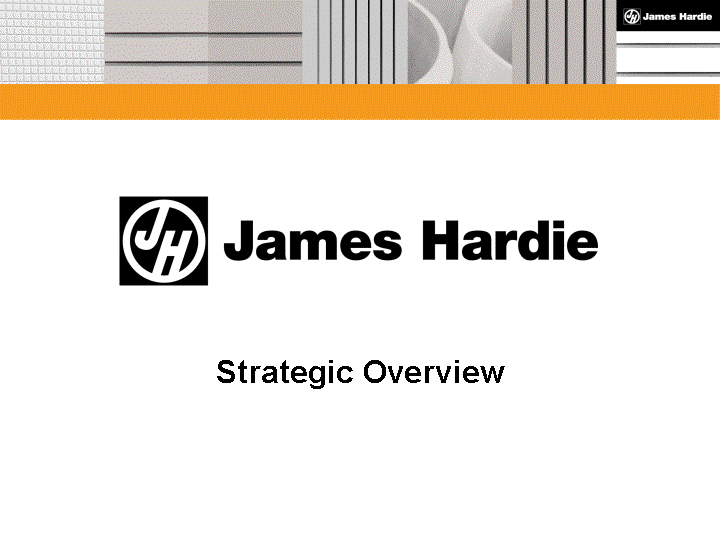
| Strategic Overview |
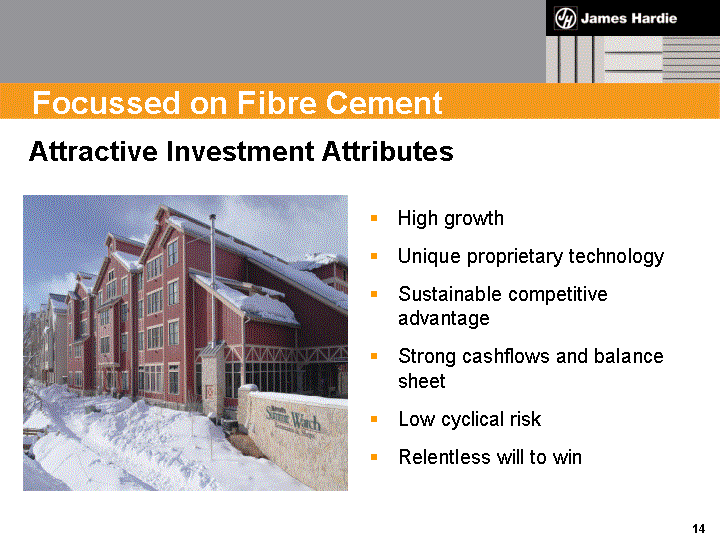
| Focussed on Fibre Cement High growth Unique proprietary technology Sustainable competitive advantage Strong cashflows and balance sheet Low cyclical risk Relentless will to win Attractive Investment Attributes |
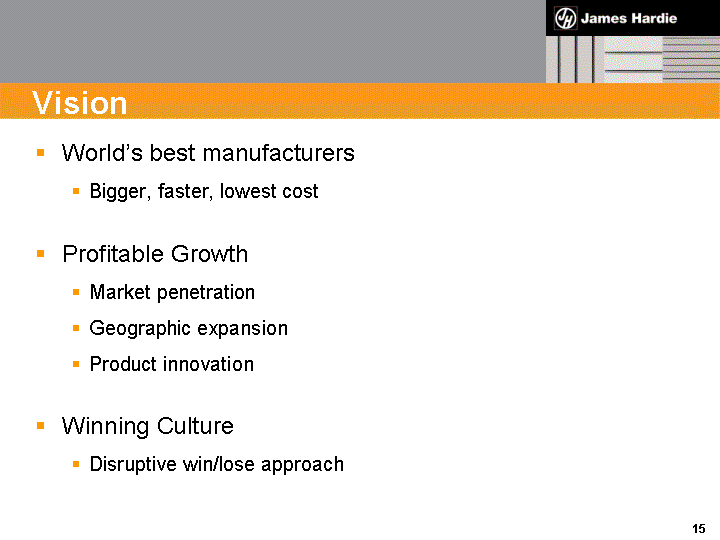
| Vision World's best manufacturers Bigger, faster, lowest cost Profitable Growth Market penetration Geographic expansion Product innovation Winning Culture Disruptive win/lose approach |

| Strategy Industry Leadership and Profitable Growth Aggressively grow the market Secure differentiated position Generate strong top line growth Win high shares of large segments Sustain attractive margins |
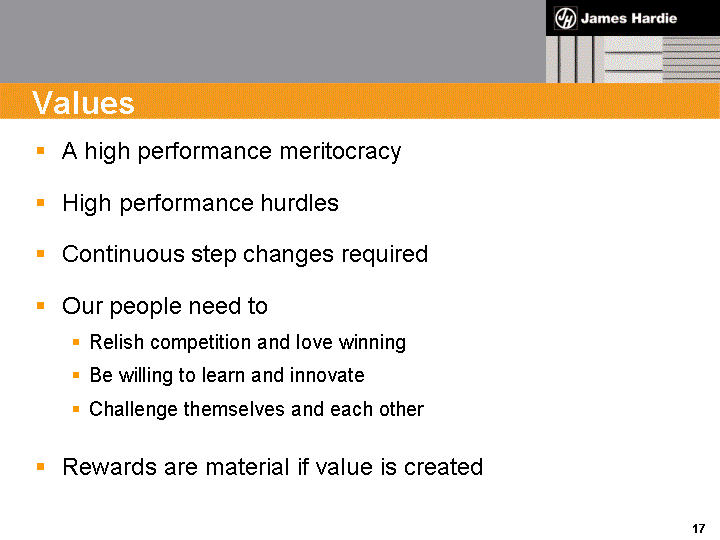
| Values A high performance meritocracy High performance hurdles Continuous step changes required Our people need to Relish competition and love winning Be willing to learn and innovate Challenge themselves and each other Rewards are material if value is created |

| Business portfolio balanced to achieve short and long term growth USA expected to double between 2002 - 2007 Growth and attractive returns from ANZ Numerous opportunities for growth > 5 years Pipes Roofing Europe Chile Asset mix reflects this Portfolio To Sustain Growth |

| Balanced Portfolio GCE Sales EBIT USA - - Established high growth/high return 70% 75% 89% Asia Pacific - - Established high return 21% 24% 17% Other - - Emerging opportunities (Pipes, Roofing, Europe, Chile) 9% 1% (6%) Total 100% 100% 100% |
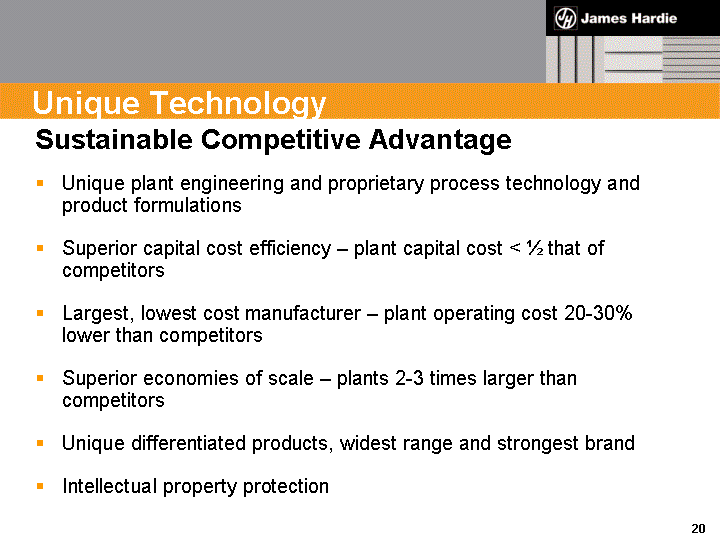
| Unique Technology Sustainable Competitive Advantage Unique plant engineering and proprietary process technology and product formulations Superior capital cost efficiency - plant capital cost < 1/2 that of competitors Largest, lowest cost manufacturer - plant operating cost 20-30% lower than competitors Superior economies of scale - plants 2-3 times larger than competitors Unique differentiated products, widest range and strongest brand Intellectual property protection |
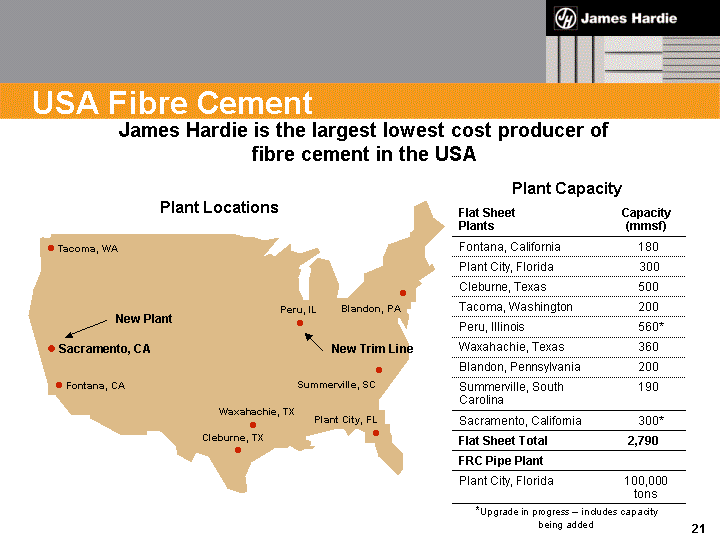
| USA Fibre Cement James Hardie is the largest lowest cost producer of fibre cement in the USA Plant Locations Flat Sheet Plants Capacity (mmsf) Fontana, California 180 Plant City, Florida 300 Cleburne, Texas 500 Tacoma, Washington 200 Peru, Illinois 560* Waxahachie, Texas 360 Blandon, Pennsylvania 200 Summerville, South Carolina 190 Sacramento, California 300* Flat Sheet Total 2,790 FRC Pipe Plant Plant City, Florida 100,000 tons Plant Capacity *Upgrade in progress - includes capacity being added Tacoma, WA Fontana, CA Plant City, FL Waxahachie, TX Cleburne, TX Peru, IL Blandon, PA Summerville, SC Sacramento, CA New Trim Line New Plant |
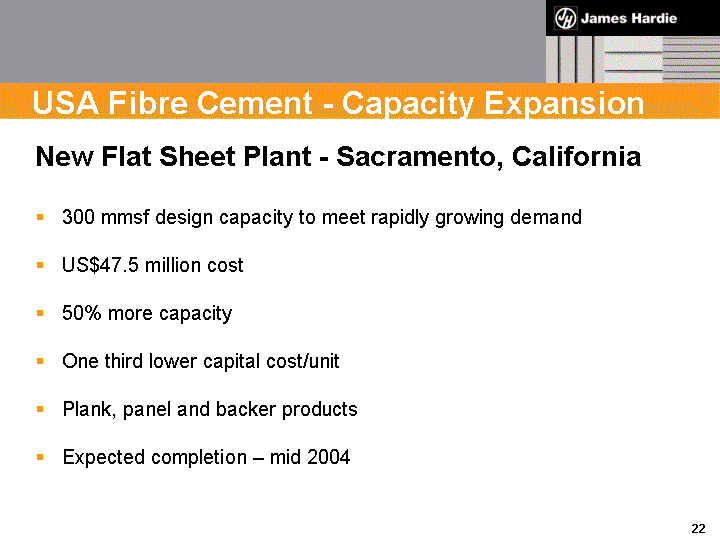
| USA Fibre Cement - Capacity Expansion New Flat Sheet Plant - Sacramento, California 300 mmsf design capacity to meet rapidly growing demand US$47.5 million cost 50% more capacity One third lower capital cost/unit Plank, panel and backer products Expected completion - mid 2004 |

| Increased Scale 1990 1994 1998 2001 2003 mmsf 60 100 150 200 300 Production Capacity Per Line |

| Lower Capital Cost 1990 1995 1997 1998 2000 2003 USD/sf Capital Cost/Unit of Capacity |
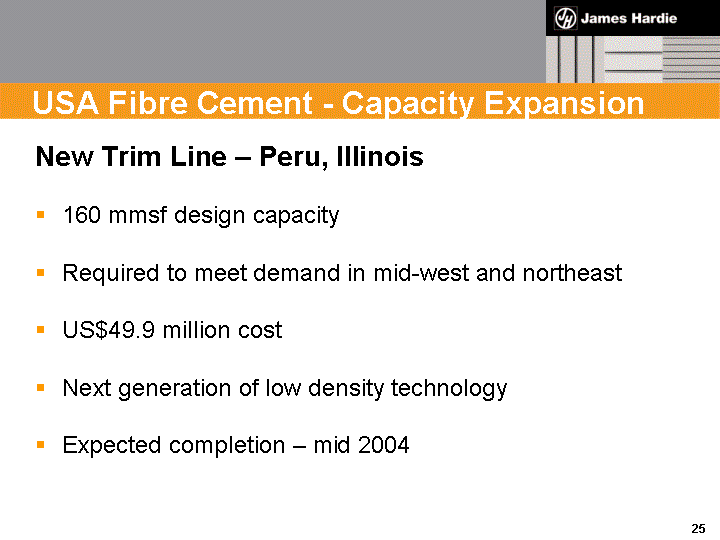
| New Trim Line - Peru, Illinois 160 mmsf design capacity Required to meet demand in mid-west and northeast US$49.9 million cost Next generation of low density technology Expected completion - mid 2004 USA Fibre Cement - Capacity Expansion |
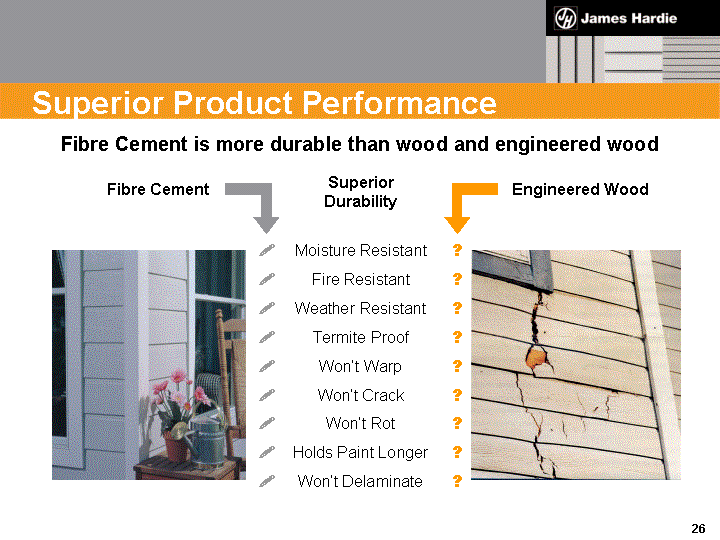
| Superior Product Performance Fibre Cement is more durable than wood and engineered wood Fibre Cement Superior Durability Moisture Resistant Fire Resistant Weather Resistant Termite Proof Won't Warp Won't Crack Won't Rot Holds Paint Longer Won't Delaminate ? ? ? ? ? ? ? ? ? ? ? ? ? ? ? ? ? ? Engineered Wood |
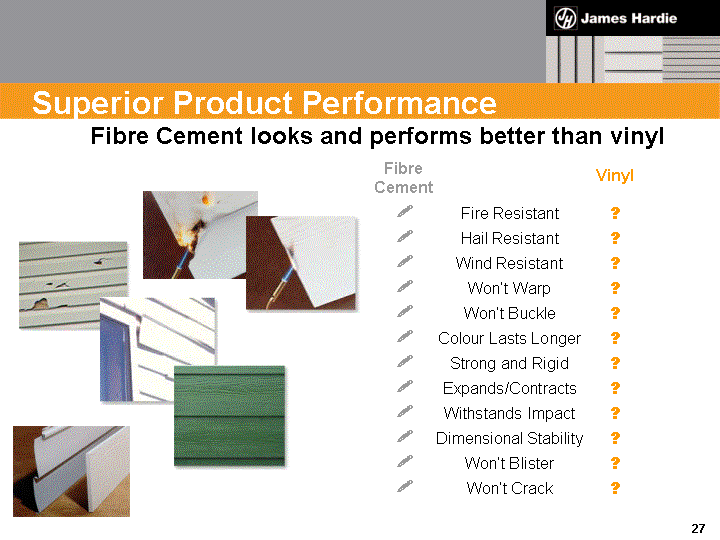
| Superior Product Performance Fibre Cement looks and performs better than vinyl Vinyl Fire Resistant Hail Resistant Wind Resistant Won't Warp Won't Buckle Colour Lasts Longer Strong and Rigid Expands/Contracts Withstands Impact Dimensional Stability Won't Blister Won't Crack ? ? ? ? ? ? ? ? ? ? ? ? ? ? ? ? ? ? ? ? ? ? ? ? Fibre Cement |
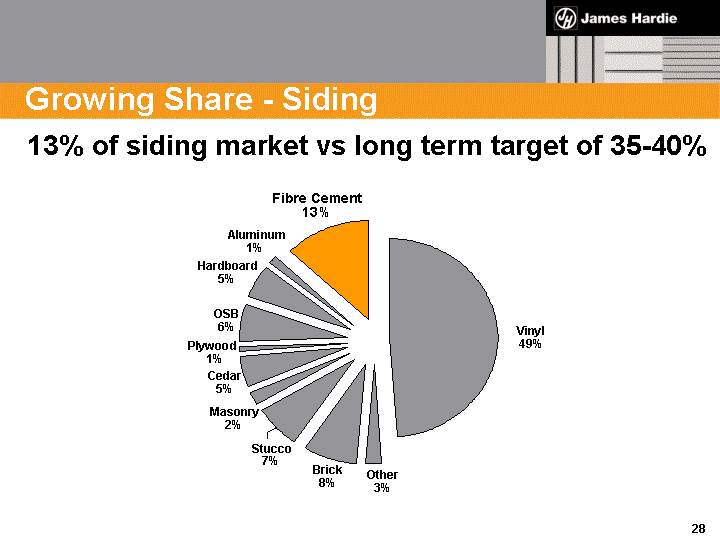
| Growing Share - Siding 13% of siding market vs long term target of 35-40% Vinyl 49% Plywood 1% OSB 6% Hardboard 5% Aluminum 1% Stucco 7% Cedar 5% Masonry 2% Fibre Cement 13% Brick 8% Other 3% |
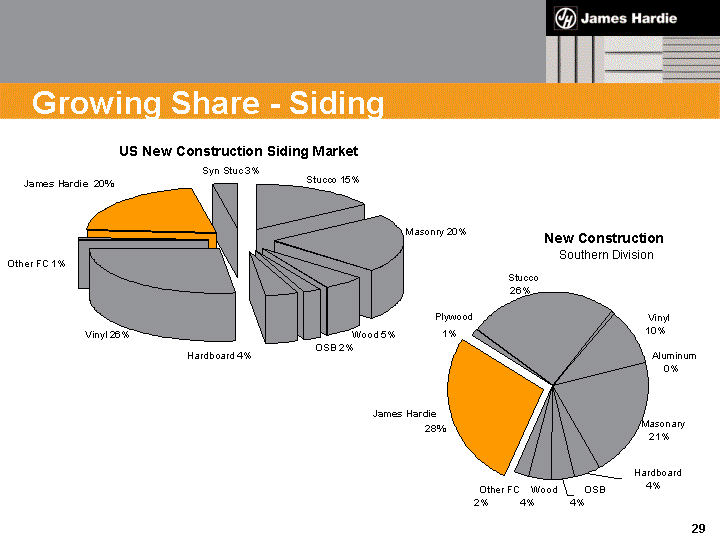
| 4% 2% 4% Masonary Plywood Aluminum New Construction Southern Division Vinyl 10% 21% Wood Other FC Stucco 26% 28% 0% Hardboard 4% OSB James Hardie 1% Other FC 1% US New Construction Siding Market Hardboard 4% James Hardie 20% Stucco 15% Masonry 20% Wood 5% OSB 2% Vinyl 26% Syn Stuc 3% Growing Share - Siding |
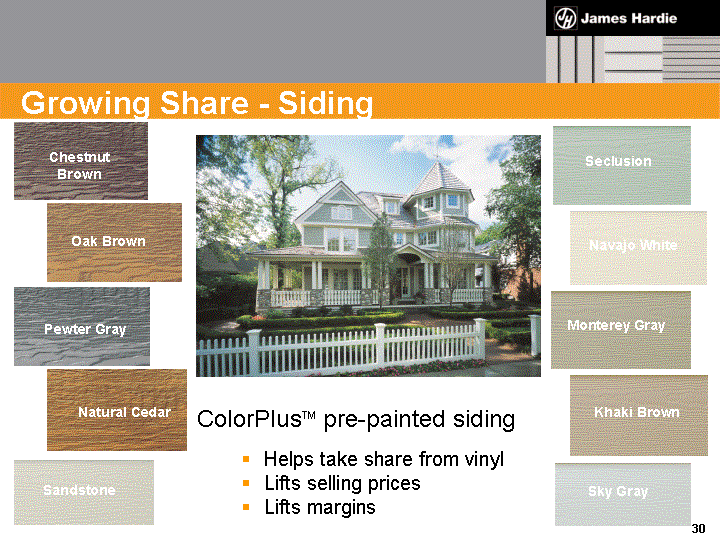
| Growing Share - Siding Oak Brown Pewter Gray Chestnut Brown Sandstone Navajo White Khaki Brown Monterey Gray Seclusion Sky Gray ColorPlusTM pre-painted siding Helps take share from vinyl Lifts selling prices Lifts margins |
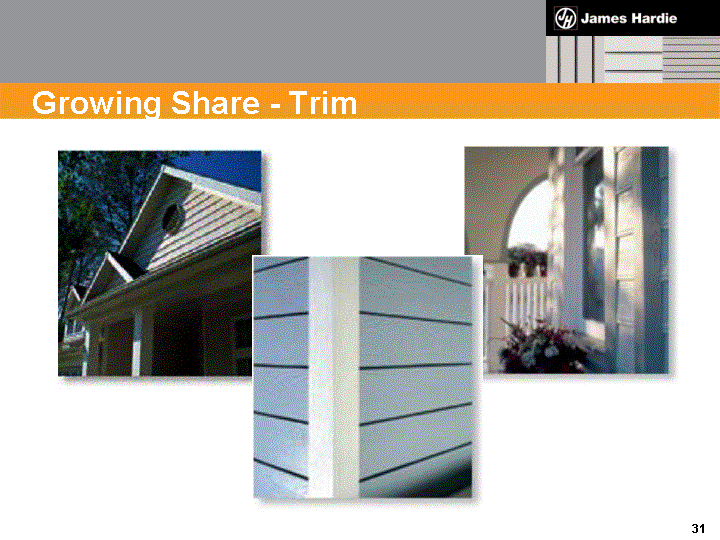
| Growing Share - Trim |
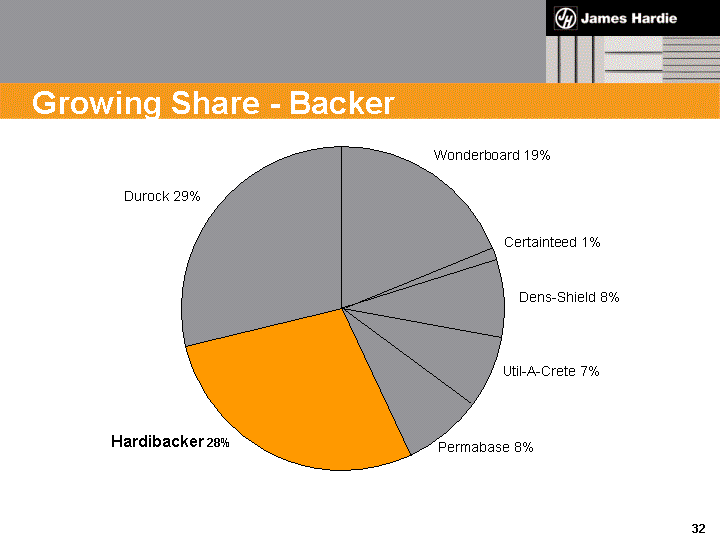
| Wonderboard 19% Certainteed 1% Dens-Shield 8% Util-A-Crete 7% Permabase 8% Hardibacker 28% Durock 29% Growing Share - Backer |
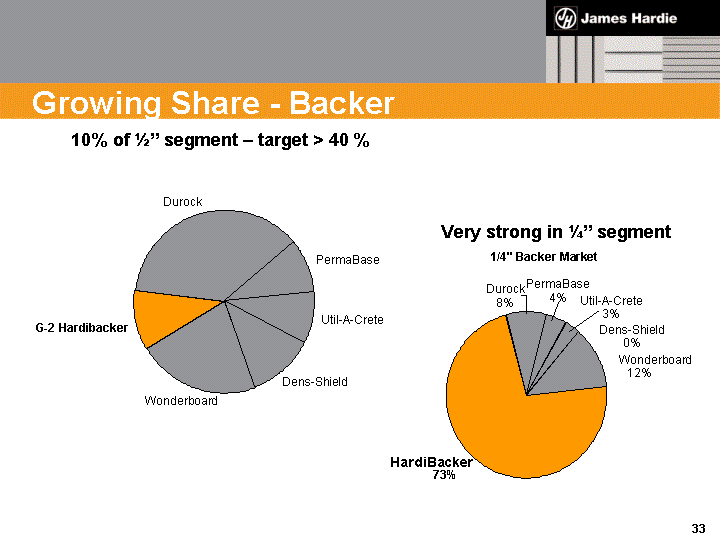
| Growing Share - Backer HardiBacker 1/4" Backer Market Dens-Shield 0% 73% PermaBase 4% Util-A-Crete 3% Wonderboard 12% Durock 8% Very strong in 1/4" segment Dens-Shield G-2 Hardibacker PermaBase Util-A-Crete Wonderboard Durock 10% of 1/2" segment - target > 40 % |

| Soffit Growth 1997 1998 1999 2000 2001 2002 2003 FY00 FY01 FY02 FY03 Retail Growth 1997 1998 1999 2000 2001 2002 2003 Siding Growth Trim Growth FY00 FY01 FY02 FY03 Numerous Growth Dimensions 1/4" Hardibacker Growth FY97 FY98 FY99 FY00 FY01 FY02 FY03 1/2" Hardibacker Growth FY97 FY98 FY99 FY00 FY01 FY02 FY03 |
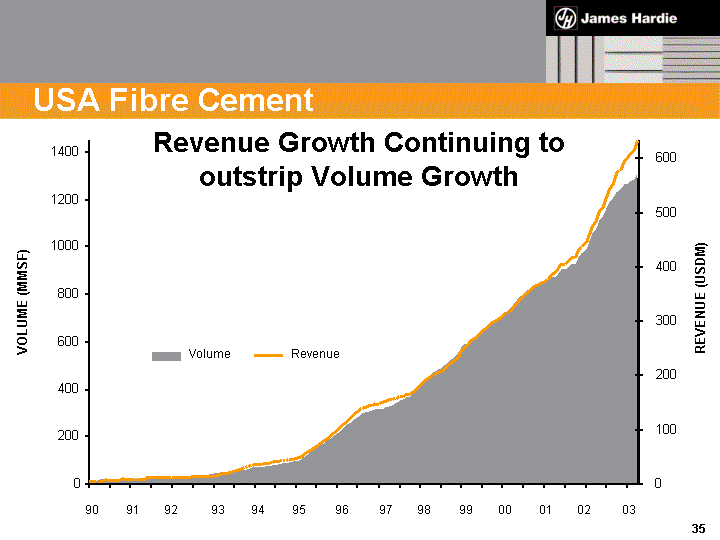
| USA Fibre Cement Revenue Growth Continuing to outstrip Volume Growth 0 200 400 600 800 1000 1200 1400 VOLUME (MMSF) 0 100 200 300 400 500 600 REVENUE (USDM) Volume Revenue 90 00 01 02 97 98 93 92 91 95 96 94 99 03 |
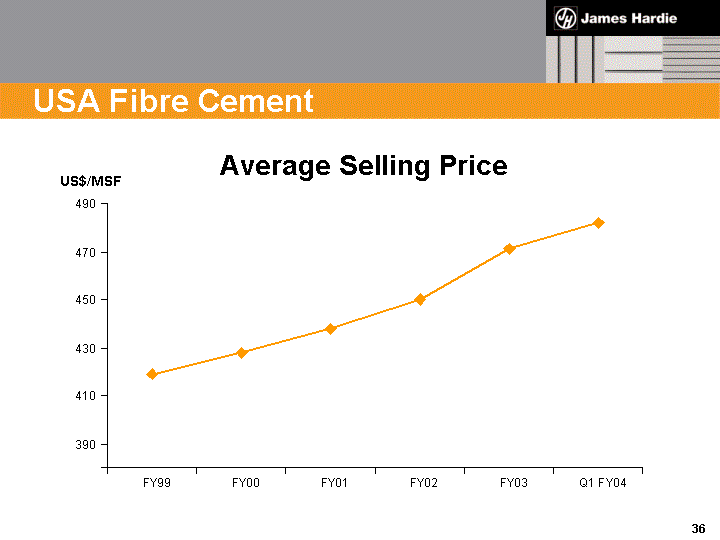
| USA Fibre Cement Average Selling Price 390 410 430 450 470 490 FY99 FY00 FY01 FY02 FY03 Q1 FY04 US$/MSF |
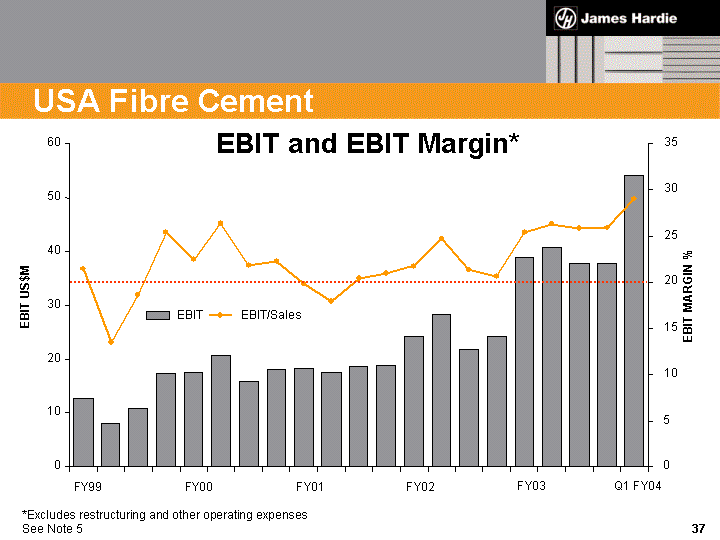
| USA Fibre Cement *Excludes restructuring and other operating expenses See Note 5 EBIT US$M 0 10 20 30 40 50 60 FY99 FY00 FY01 FY02 FY03 0 5 10 15 20 25 30 35 EBIT MARGIN % EBIT EBIT/Sales Q1 FY04 EBIT and EBIT Margin* |
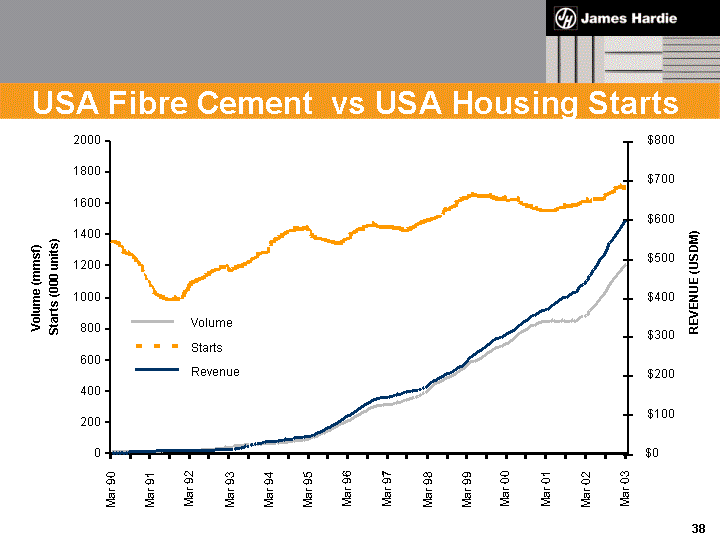
| USA Fibre Cement vs USA Housing Starts 0 200 400 600 800 1000 1200 1400 1600 1800 2000 Mar 90 Mar 91 Mar 92 Mar 93 Mar 94 Mar 95 Mar 96 Mar 97 Mar 98 Mar 99 Mar 00 Mar 01 Mar 02 Mar 03 Volume (mmsf) Starts (000 units) $0 $100 $200 $300 $400 $500 $600 $700 $800 REVENUE (USDM) Volume Starts Revenue |
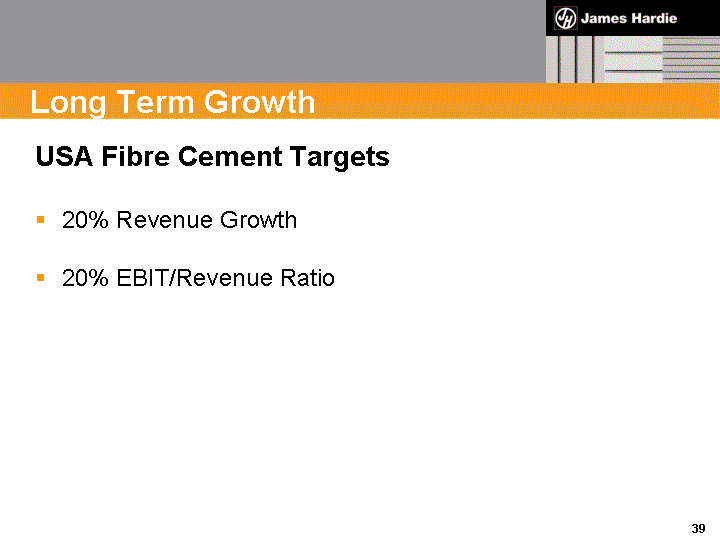
| Long Term Growth USA Fibre Cement Targets 20% Revenue Growth 20% EBIT/Revenue Ratio |
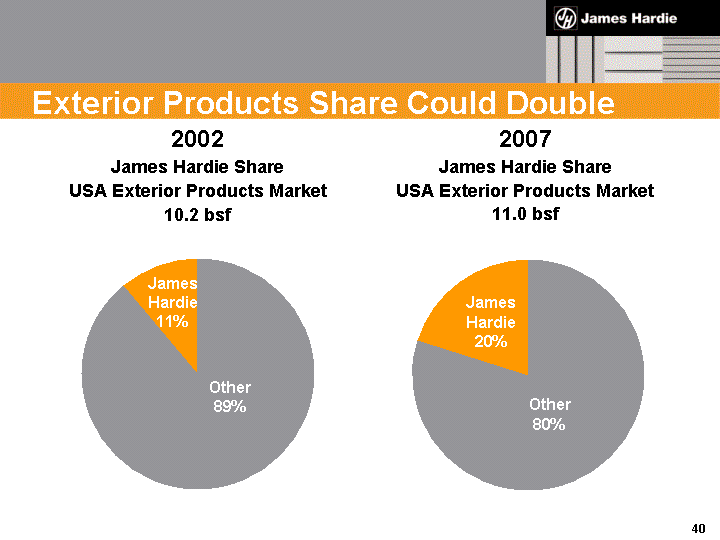
| 2002 James Hardie Share USA Exterior Products Market 10.2 bsf 2007 James Hardie Share USA Exterior Products Market 11.0 bsf James Hardie 11% Other 89% James Hardie 20% Other 80% Exterior Products Share Could Double |
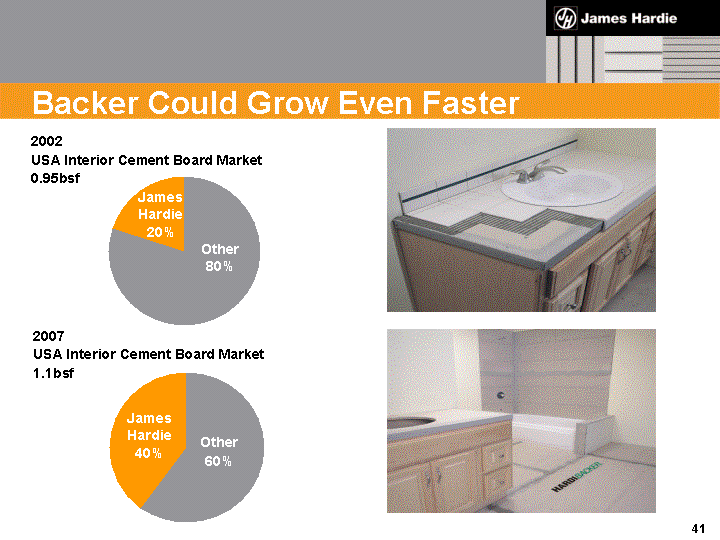
| Backer Could Grow Even Faster 2002 USA Interior Cement Board Market 0.95bsf James Hardie 20% Other 80% 2007 USA Interior Cement Board Market 1.1bsf James Hardie 40% Other 60% |
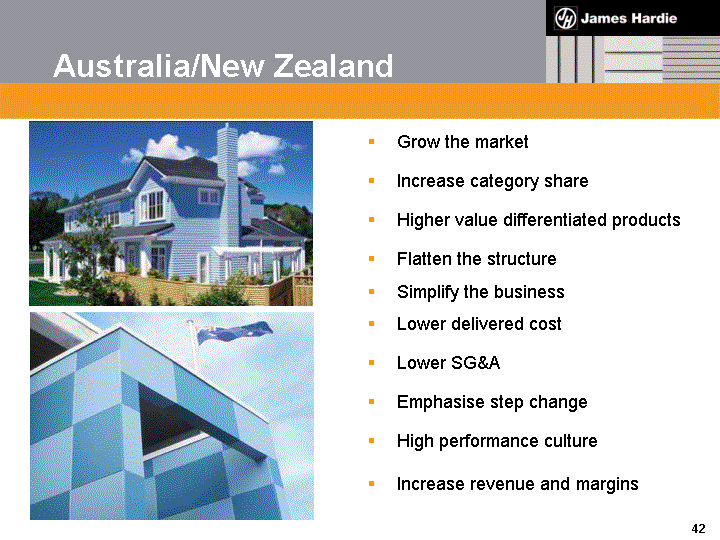
| Australia/New Zealand Grow the market Increase category share Higher value differentiated products Flatten the structure Simplify the business Lower delivered cost Lower SG&A Emphasise step change High performance culture Increase revenue and margins |
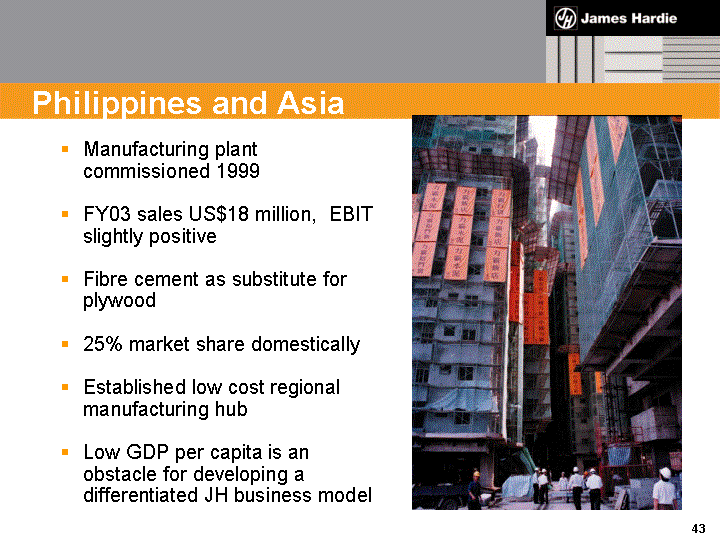
| Philippines and Asia Manufacturing plant commissioned 1999 FY03 sales US$18 million, EBIT slightly positive Fibre cement as substitute for plywood 25% market share domestically Established low cost regional manufacturing hub Low GDP per capita is an obstacle for developing a differentiated JH business model |
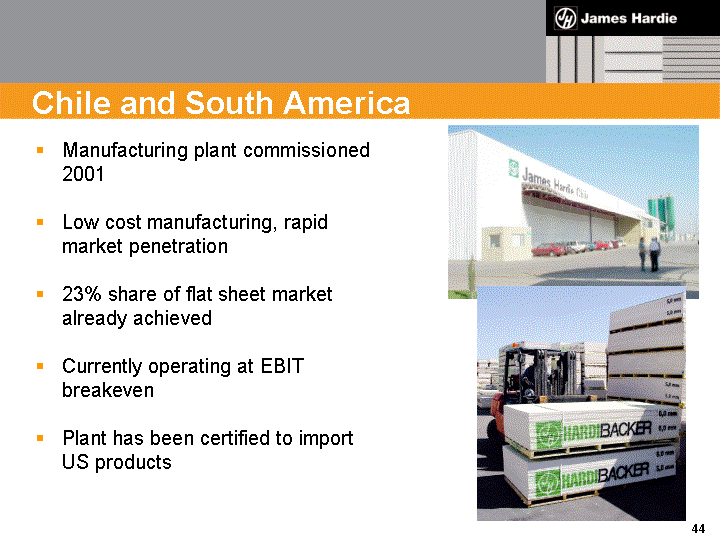
| Chile and South America Manufacturing plant commissioned 2001 Low cost manufacturing, rapid market penetration 23% share of flat sheet market already achieved Currently operating at EBIT breakeven Plant has been certified to import US products |
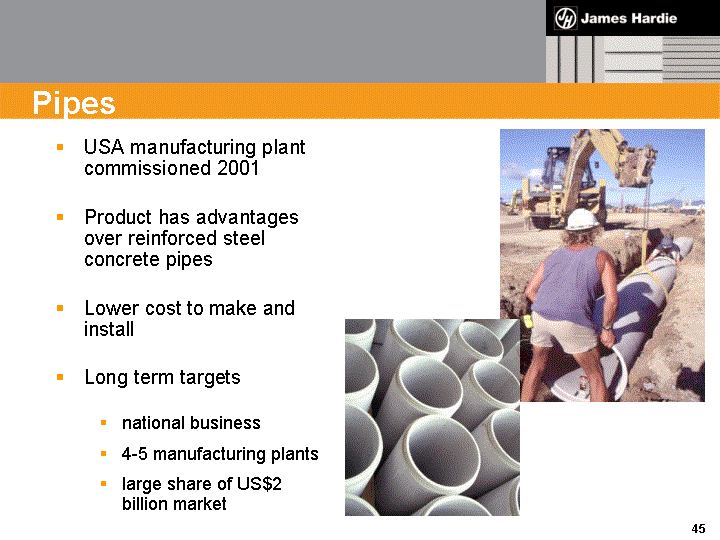
| USA manufacturing plant commissioned 2001 Product has advantages over reinforced steel concrete pipes Lower cost to make and install Long term targets national business 4-5 manufacturing plants large share of US$2 billion market Pipes |
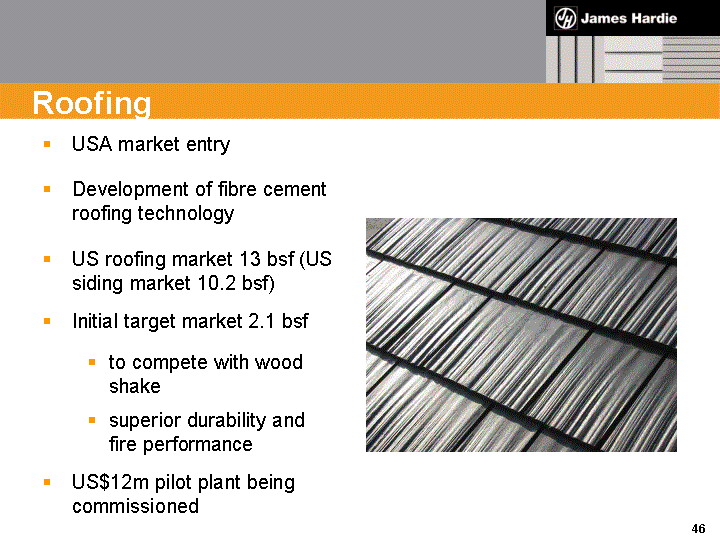
| Roofing USA market entry Development of fibre cement roofing technology US roofing market 13 bsf (US siding market 10.2 bsf) Initial target market 2.1 bsf to compete with wood shake superior durability and fire performance US$12m pilot plant being commissioned |
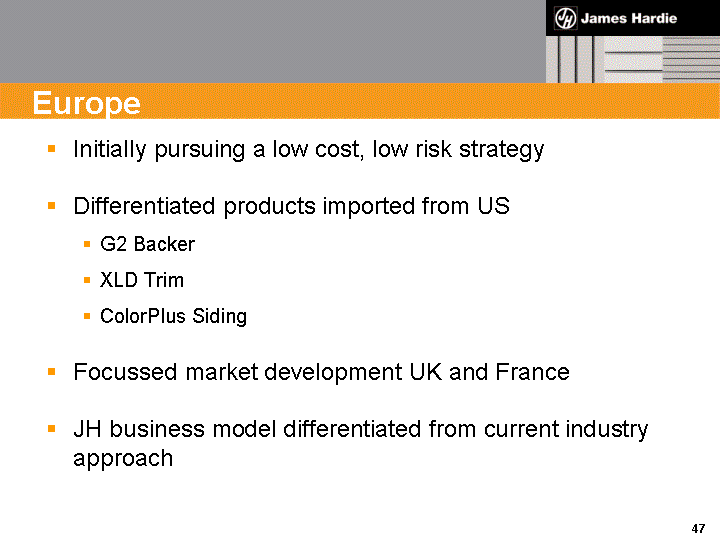
| Europe Initially pursuing a low cost, low risk strategy Differentiated products imported from US G2 Backer XLD Trim ColorPlus Siding Focussed market development UK and France JH business model differentiated from current industry approach |
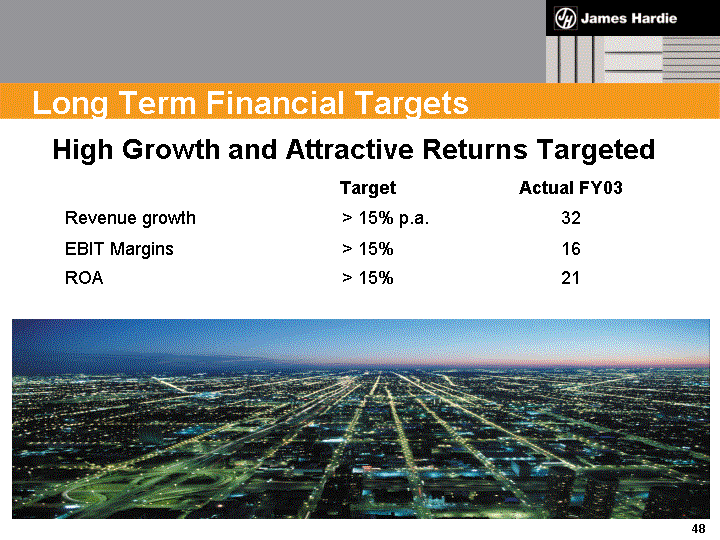
| High Growth and Attractive Returns Targeted Long Term Financial Targets Target Actual FY03 Revenue growth > 15% p.a. 32 EBIT Margins > 15% 16 ROA > 15% 21 |
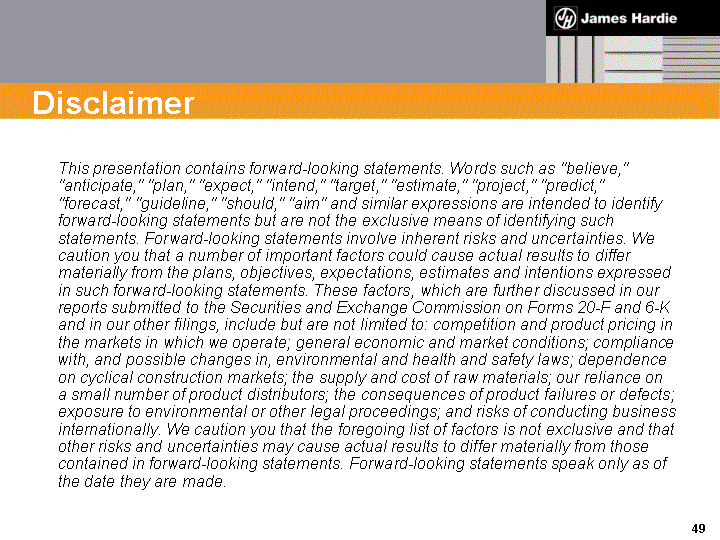
| Disclaimer This presentation contains forward-looking statements. Words such as "believe,'' "anticipate,'' "plan,'' "expect,'' "intend,'' "target,'' "estimate,'' "project,'' "predict,'' "forecast,'' "guideline,'' "should,'' "aim'' and similar expressions are intended to identify forward-looking statements but are not the exclusive means of identifying such statements. Forward-looking statements involve inherent risks and uncertainties. We caution you that a number of important factors could cause actual results to differ materially from the plans, objectives, expectations, estimates and intentions expressed in such forward-looking statements. These factors, which are further discussed in our reports submitted to the Securities and Exchange Commission on Forms 20-F and 6-K and in our other filings, include but are not limited to: competition and product pricing in the markets in which we operate; general economic and market conditions; compliance with, and possible changes in, environmental and health and safety laws; dependence on cyclical construction markets; the supply and cost of raw materials; our reliance on a small number of product distributors; the consequences of product failures or defects; exposure to environmental or other legal proceedings; and risks of conducting business internationally. We caution you that the foregoing list of factors is not exclusive and that other risks and uncertainties may cause actual results to differ materially from those contained in forward-looking statements. Forward-looking statements speak only as of the date they are made. |
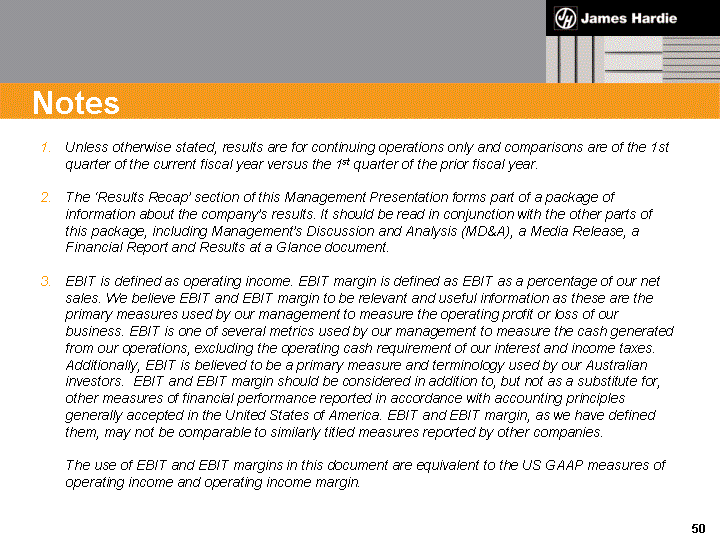
| Notes Unless otherwise stated, results are for continuing operations only and comparisons are of the 1st quarter of the current fiscal year versus the 1st quarter of the prior fiscal year. The 'Results Recap' section of this Management Presentation forms part of a package of information about the company's results. It should be read in conjunction with the other parts of this package, including Management's Discussion and Analysis (MD&A), a Media Release, a Financial Report and Results at a Glance document. EBIT is defined as operating income. EBIT margin is defined as EBIT as a percentage of our net sales. We believe EBIT and EBIT margin to be relevant and useful information as these are the primary measures used by our management to measure the operating profit or loss of our business. EBIT is one of several metrics used by our management to measure the cash generated from our operations, excluding the operating cash requirement of our interest and income taxes. Additionally, EBIT is believed to be a primary measure and terminology used by our Australian investors. EBIT and EBIT margin should be considered in addition to, but not as a substitute for, other measures of financial performance reported in accordance with accounting principles generally accepted in the United States of America. EBIT and EBIT margin, as we have defined them, may not be comparable to similarly titled measures reported by other companies. The use of EBIT and EBIT margins in this document are equivalent to the US GAAP measures of operating income and operating income margin. |
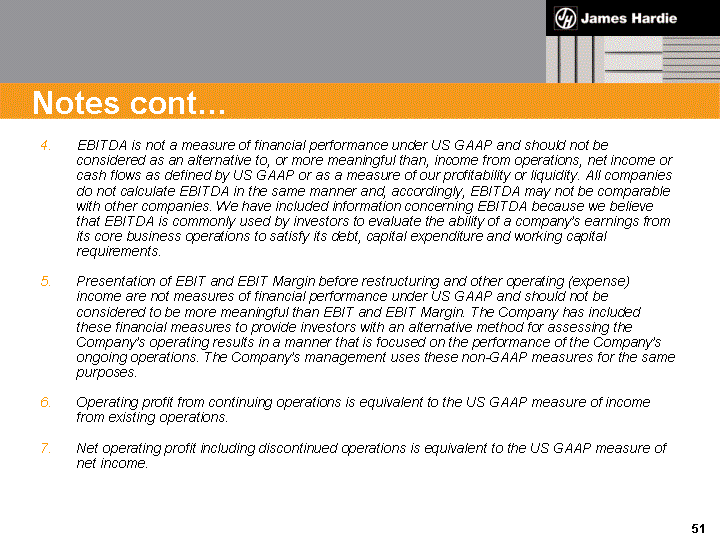
| Notes cont... 4. EBITDA is not a measure of financial performance under US GAAP and should not be considered as an alternative to, or more meaningful than, income from operations, net income or cash flows as defined by US GAAP or as a measure of our profitability or liquidity. All companies do not calculate EBITDA in the same manner and, accordingly, EBITDA may not be comparable with other companies. We have included information concerning EBITDA because we believe that EBITDA is commonly used by investors to evaluate the ability of a company's earnings from its core business operations to satisfy its debt, capital expenditure and working capital requirements. Presentation of EBIT and EBIT Margin before restructuring and other operating (expense) income are not measures of financial performance under US GAAP and should not be considered to be more meaningful than EBIT and EBIT Margin. The Company has included these financial measures to provide investors with an alternative method for assessing the Company's operating results in a manner that is focused on the performance of the Company's ongoing operations. The Company's management uses these non-GAAP measures for the same purposes. Operating profit from continuing operations is equivalent to the US GAAP measure of income from existing operations. Net operating profit including discontinued operations is equivalent to the US GAAP measure of net income. |
